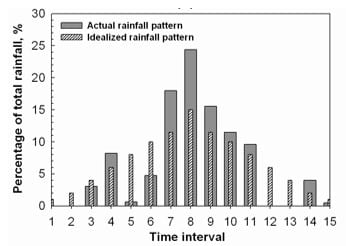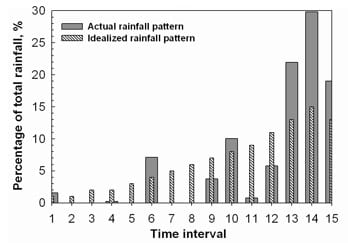
Locations of slopes for case studies in Singapore, Rahardjo et al 2012
Case Studies
Case study 1

Soil profile used in the numerical analyses of Slope A, Rahardjo et al 2011
Case study 1 shows that the residual soil slope from Bukit Timah Granite had a higher initial factor of safety than the residual soil slope from sedimentary Jurong Formation. The factor of safety of the residual soil slope from Bukit Timah Granite decreased drastically until it reached minimum factor of safety at the end of rainfall. This occurred due to the fact that water percolated down very fast through the soil layer until deeper depths, causing a rapid increase in the pore-water pressures in the slope. Meanwhile, the factor of safety in the residual soil slope from sedimentary Jurong Formation decreased gradually until reaching the minimum factor of safety several hours after rain stopped. The characteristics of factor of safety variation of the residual soil slope from sedimentary Jurong Formation during rainfall can be used to explain many incidences of slope failures that occurred some time after rainfall had ceased (i.e. delayed slope failures).
Case study 2



Actual and idealized rainfall patterns for rainfall data of December 2006: (a) increasing intensity towards the end of rainfall, (b) maximum intensity at the middle of rainfall and (c) decreasing intensity towards the end of rainfall, Rahardjo et al 2011

Normalized factor of safety versus time for various rainfall patterns, Rahardjo et al 2011
References
- Harnas, F., Rahardjo, H., Leong, E. C. and Wang, J. Y. (2014). “An experimental study on dual capillary barrier using recycled asphalt pavement materials.” Canadian Geotechnical Journal, May, 51(10), 1165-1177. doi
- Rahardjo, H., Satyanaga, A., Leong, E. C., Ng, Y. S. and Pang, H. T. C. (2012). “Variability of residual soil properties.” Engineering Geology, July, 141–142, 124–140. doi | handle
- Rahardjo, H., Santoso, V. A., Leong, E. C., Ng, Y. S. and Hua, C. J. (2011). “Numerical analyses and monitoring performance of residual soil slopes.” Soils and Foundations, Japanese Geotechnical Society, June, 51(3), 471-482. doi | handle
- Rahimi, A., Rahardjo, H. and Leong, E. C. (2011). “Effect of antecedent rainfall patterns on rainfall-induced slope failure.” Journal of Geotechnical and Geoenvironmental Engineering, May, 137(5), 483-491. doi | handle
- Rahardjo, H., Santoso, V. A., Leong, E. C., Ng, Y. S. and Hua, C. J. (2011). “Performance of horizontal drains in residual soil slope.” Soils and Foundations, Japanese Geotechnical Society, June, 51(3), 437-447. doi | handle
